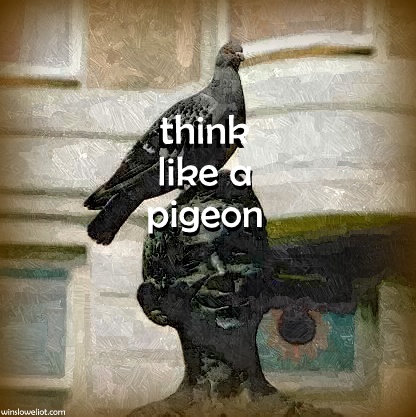think like a pigeon.

I awake to the soft cooing of a pigeon in the yard, which is unusual where I live. It blends with the pouring rain and steeps me in reminiscence: I’ve always loved pigeons and the soft cooing brings back a rush of memories: sitting by a fountain in Piazza Navona, on a bench in St Mark’s Square, waiting for a friend at Victoria Station, or simply on every rooftop when I lifted my eyes all those many years I lived in New York City. In spite of the intense nostalgia I feel, the sound makes me happy. I want to embody the pigeon-ness that is within all of us as I lean out the window and blow it a kiss. Pigeons are remarkable creatures: they’re monogamous and protective, as well as very lovey-dovey with each other. They take their parenting responsibilities seriously and share equally in all of them. They dote on their adorable babies, who we rarely encounter since their parents insist they remain in the nest until they’re practically adults. They’re playful—I’ve seen videos of them repeatedly using a jar top for a slide down the short side of a roof. They’re also known to do backflips in midair “for no reason at all”—but I know the reason: it’s fun to do backward somersaults while you’re flying! They’re serious too: if they have to, they can learn the alphabet and are pretty good at math. And they can fly fast, up to 100 miles per hour. They can find their home from great distances even blindfolded, but they have better eyesight than most humans (the U.S. Coast Guard uses them to sight orange life jackets of lost swimmers or boaters); they also see way more colors than we can. They recognize us even from the back, and are affectionate if we’ve been kind to them. It’s good to recognize in ourselves the traits of any creature we encounter in dreams or real life, but it’s also good to value and appreciate the creature itself for its own wonderful, extraordinary existence. Thank you, Pigeon.
